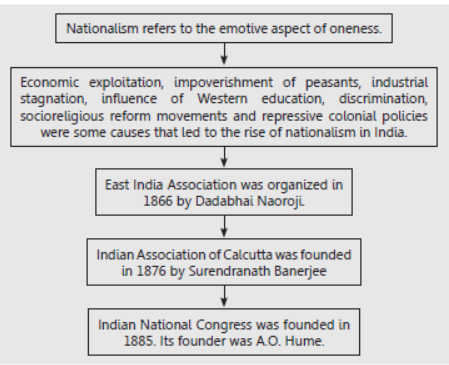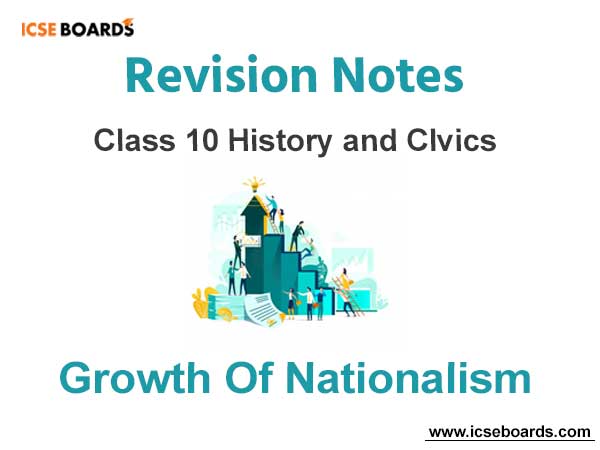ICSE students should refer to Growth of Nationalism ICSE Class 10 History notes provided below. These revision notes have been prepared based on the latest ICSE Class 10 History Books for the current academic year. Revising notes prior to the exams is really important to get excellent marks in History Class 10 exams. Also, refer to ICSE Class 10 History solutions to understand all chapters properly.
ICSE Class 10 History and Civics Growth of Nationalism
Students can refer to the quick revision notes prepared for Chapter Growth of Nationalism in Class 10 ICSE. These notes will be really helpful for the students giving the History and Civics exam in ICSE Class 10. Our teachers have prepared these concept notes based on the latest ICSE syllabus and ICSE books issued for the current academic year.
Growth of Nationalism ICSE Class 10 History
Flow chart

Know the terms
• Repeal – To undo law, to officially end validity of something such as a law
• Sovereign – The capacity to act independently without outside interference.
• Council – An appointed or selected body of people with an administrative, advisory or representative function.
• Nationalism – A sense of belongingness to one nation.
• Vernacular Press Act – This Act was passed to suppress the freedom of the Indian Press. The Act required the
editors to publish nothing.
• The Indian Arms Act 1878 – This Act made it criminal offence for Indians to carry arms without licence. This Act was not applicable to the Britishers.
Know the dates
• 1828 – Formation of Brahmo Samaj
• 1866 – Formation of East India Association
• 1875 – Formation of Arya Samaj
• 1878 – Vernacular Press Act and Arms Act
• 1885 – Formation of Indian National Congress
Know the Personalities
• Sir Syed Ahmad Khan – He founded the Mohammedan Anglo-Oriental College at Aligarh in 1877.
• Swami Vivekananda – This great reformer condemned the caste system and emphasis on rituals and ceremonies.z z Jyotiba Phule – He belonged to a lower caste family from Maharashtra. He waged a life-long struggle against caste discrimination and Brahmanical supremacy.
• Dadabhai Naoroji – Called the ‘Grand Old Man of India’, he organized the East India Association in 1866 in London.
• Surendranath Bannerjee – He founded the Indian Association of Calcutta in 1876.
• Allan Octavian Hume – He was a retired civil servant who founded the Indian National Congress in 1885.
Factors Leading to Growth of Nationalism in India
Quick review
1. The origination of nationalism is one of the most distinguishing features of the second half of the 19th century.
2. The word ‘nation’ was used as a synonym for race. It was during the Industrial Revolution that its meaning changed to include not only all people speaking a common language, having common cultural traditions and living within a defined geographical area but also having a common political identity.
3. Factors for the Rise of Nationalism
(i) Racial Discrimination – The British policy of racial discrimination hurt the sentiments of the Indians.
• The British never mixed with the Indians. They had their separate living areas, clubs, theatres where Indians were not welcomed.
• All the jobs in the civil services or the Army were reserved for the British and other Europeans who often took pride in insulting the Indians.
• The Arms Act of 1878 was also openly discriminatory. This Act required Indians to have a license to carry or keep arms, while Europeans could do so without a license. This license was seen as a ‘badge of inferiority’ for the Indians, who were very upset.
• In matter of justice Europeans were given special treatment – Indians were tried in separate courts while Europeans had special courts.
• The withdrawal of Illbert Bill of 1883 that attempted to make Indian Judges equal in status to their British counterpart as regards criminal jurisdiction was another illustration of racial discrimination.
(ii) Influence of Western Education
• The British introduced Western education in India through the medium of English to serve their own representative. They wanted to train Indian people as clerks so as to run their own administration.
• The British wanted to rear their culture and conquer the goodwill of the educated Indians. But educated Indians were the first to feel the humiliations of foreign rulers.
• Western education, through the study of European history, political thought and economic ideas gave the educated Indians a rational, secular, democratic and national outlook. The slogan – ‘Equality, Liberty and Fraternity’ of the American and French Revolutions impressed all the educated Indians.
• Western education helped Indians to imbibe western thought and assumed the leadership of National Movement.
• English language played a leading part in this process. It was through this language that the Indians from different parts of the country could meet and exchange ideas.
• Through Western education, social and national consciousness of Indians was awakened by the revolutionary ideas of the liberal thinkers like Rousseau, Mazzini and Thomas Paine.
(iii) Economic Exploitation
• Agricultural India was made an economic colony to serve the interests of Industrial England.
• With the establishment of the British rule, the Indian handicraft industry was ruined.
• Millions of craftsmen and artisans were rendered jobless.
• The British capital invested in Indian markets especially in railway, shipping, oil exploration, tea and coffee plantation, etc. was used to help the British industries and to get huge profits as well.
• The heavy taxes that the Indians paid were not spent in India for the welfare of the people. Indian economists like Dadabhai Naoroji openly proclaimed that the British were draining all the wealth from India in the form of profits, saving, salaries and pensions.
• All the sections of Indian society felt the effects of the economic exploitation by the British and realised that quite drastic steps were needed to correct the situation. This automatically led to an upsurge of nationalist favour.
(iv) Role of Press and Indian Literature
• The press played an enormous role in fostering national unity and creating consciousness among the Indians. A large number of newspapers were started in the later half of the 18th century. Both the Vernacular and the English Press contributed greatly to the spread of nationalism. Some of the prominent newspapers were the Amrit Bazar Patrika, The Bengali, The Tribune, The Pioneer, The Times of India, The Hindu and The Statesman in English.
• Indian books written at this time, inspired the Indians.
• Bankim Chandra’s Anandmath and the play Bharat Durdasha inspired countless Indians.
(v) The Vernacular Press Act – The Vernacular Act forbade the vernacular papers to publish anymore against the British Government. This Act was not applicable to English newspapers. In 1881, this was repealed by Lord Ripon.
(vi) Development of transport and the means of communication
• The first railway line connecting Bombay with Thane was laid down in 1853. By 1869, more than 6000 km of railways had been built, extending to nearly 45,000 km by 1905. Besides encouraging trade and commerce, the railway facilitated the growth of nationalism.
• A network of roads and railways made it easy for people to travel from one part of India to another part and soon the people realized the basic unity of Indians. People slowly started thinking of themselves belonging to one country thus, slowly overcoming regional disparities.
• The fact that a very large part of India had been conquered and was under the British rule meant the same and similar laws in most of the country. This meant there were common problems and common solutions for almost the whole of India which automatically led to unity among the people.
(vii) Reforms Movements
• This period saw a number of reform movements. Raja Ram Mohan Roy set up the Brahmo Samaj in 1828. He has often referred to as ‘Father of Modern Indian Renaissance’. The Brahmo Samaj believed in ‘Monotheism’ or ‘Worship of One God’. He took the issues of women emancipation and spoke against evils such as female infanticide, child marriage and Sati.
• Swami Vivekananda set up the Rama Krishna Mission in 1897, while Dayanand Saraswati set up the Arya Samaj in 1875. The Theosophical Society was set up by Col. Olcott and Madam Blavatsky.
• Jyotiba Phule, a great Maharashtrian social reformer, Set-up the Satyashodhak Samaj (Society of seekers of the truth). The society tried to liberate the lower castes, do away with untouchability and spread national thinking and was against blind faith.
• The unique feature of all these movements was that they did not ignore the political aspect of men. They all instilled confidence in the minds of the Indians and made Indians proud of their culture. Swami Dayanand Saraswati said ‘India for Indians’. This is in brief what the reformers wanted Indians to feel.
(viii) European Scholar – A number of European scholars studied ancient Indian works, translated them and helped us regain self confidence. European scholars like Max Mueller, Sir Alexander Cunningham, James Prinsep took trouble to learn about India, were full of respect. The Asiatic Society was set up to study Indian history and culture. Later the discovery of Indus Valley Civilisation, all helped to rebuild the Indian’s self-confidence. They soon became proud of the past and were ready to build a great future.
East India Company and the Foundation of Indian National Congress
Quick Review
1. East India Association
The East India Association was founded in London in 1886 by Dadabhai Naoroji, the Association provided information on all the Indian subjects to the British citizens and the Members of Parliament. The Association had its branches in Bombay, Calcutta and Madras.
2. Indian National Congress
(i) The Indian National Congress was formed by an Englishman and a retired civil servant, Allan Octavian Hume in association with various national leaders and called for a conference in Pune in December 1885.
(ii) The First Congress Session was held at Gokuldas Tejpal Sanskrit College, Bombay from 20th December to 31st December 1885 under the Presidentship of Womesh Chandra Banerjee. It was attended by 72 delegates. The Viceroy Lord Dufferin, favour the formation of the Congress because he wanted it to act as a safety valve for popular discontent thereby, safeguarding the British interests in India.
(iii) The Second Congress Session was held at Calcutta in 1886 under the Presidentship of Dadabhai Naoroji. Some
of the delegates were also received by Lord Dufferin as distinguished visitors to the Capital.
From this session onwards, participation increased steadily and the Congress sessions were held in
December each at different places in India.
Aims and Objective of the Indian National Congress :
(i) Evolution and consolidation of a feeling of national unity, irrespective of caste, religions etc.
(ii) Making the Indians politically aware.
(iii) Presentation of popular demands before the government.
(iv) Training and organization of public opinion in the country.
3. Initially the formation of Congress had the blessings of the British as place or body where Indians could vent their
grievances. Later as the Congress grew in strength and became more persistent with their petitions, the British changed their attitude towards the Congress.
4. Demands of the Congress in the early years of its formation – The Congress in its first twenty years (1885–1905) was moderate in its objectives and methods. During this period the Congress demanded:
• A great voice for Indians in the government and in administration.
• It wanted Legislative Councils to be made representative and be given more powers.
• Appointment of Indians to the Executive Council.
• Reduction of military expenditure.
• Repeal of Arms Act
• Freedom of speech and expression.
• Separation of the judiciary from the executive, etc.



